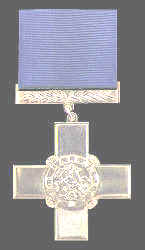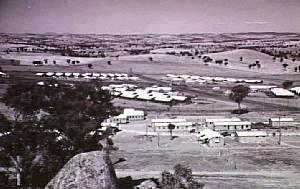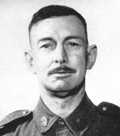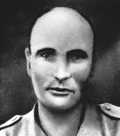 |
|
|||
|
|
||||
|
Cowra Prison Breakout |
|
August 5 1944 On Saturday, 5 August 1944 Japanese prisoners at Cowra staged a breakout that resulted in the deaths of 4 young Australians and 231 Japanese. The camp, officially known as No.12 POW Group, was a complex of four individual camps separated by cross roads. Each camp was originally built to house 1,000 prisoners.
No.12 POW Group, Cowra. Earlier, on Friday 4, in accordance with the Geneva Convention, notice was given of a transfer of all Japanese prisoners below the rank of Lance Corporal from Cowra to the Hay Prisoner of War Camp. At 0150 hours on Saturday 5 August 1944 an unauthorized bugle was heard in camp B and immediately thereafter up to 900 Japanese prisoners of war rushed from their huts and attacked the fences of the compound. The outer fence was stormed in two places, with the prisoners using blankets and baseball gloves to minimize the damage inflicted by the barbed wire fencing. Others set fire to eighteen of the camps twenty huts while those incapable of activity committed suicide by hanging or stabbing themselves, their bodies being burnt in the fires. Those that did not want to become involved were murdered by their comrades. Armed with a wide assortment of weapons, including knives, one group attacked the crew of a Vickers gun that was stationed outside the camp. Members of the 22nd Garrison Battalion opened fire, causing a large number of casualties. During the ensuring nine days 334 prisoners were retaken, of which 25 were dead. Of the dead, 11 were found hanging from trees and two had been killed by trains. In all, 231 Japanese POW's were killed and 108 wounded. One Australian Officer was killed along with three Australian other ranks, while four others were wounded. This made Cowra the largest POW breakout, eclipsing other well known Break-outs such as the "great escape" from Stalag Luft III.
|
|
THE JAPANESE Of all the prisoners housed in Australia during the war the Japanese were undoubtedly the most bitter and resentful. Under the Japanese rules of war (known as the Bushido code) prisoners were disgraced persons. Every soldier had an obligation to die for the Emperor and if the enemy succeeded in capturing him he was expected to kill himself. The Australian guards could not even pretend to understand this attitude and saw most of the Japanese prisoners as surly and fanatical. Things were not helped when late in the war information reached Australia about the way the Japanese were treating Australian prisoners. It was this mutual incomprehension between the two races which led to the 'night of a thousand suicides' when the Japanese in the Cowra prison camp attempted a mass breakout on 5 August 1944. As a result, 231 Japanese and four Australians were killed. The Australian guards thought the Japanese were attempting to take over the camp. Actually, they were attempting to kill themselves. Yet there is no evidence to suggest that the Australian authorities treated the Japanese prisoners any differently to any other group. Unlike the Italians they were not permitted to leave the camps to work on the farms but otherwise they received the same rations and were subject to the same discipline. At no time was there any attempt to wreak revenge on the Japanese for their treatment of Australian prisoners. Unfortunately this attitude was misinterpreted by some of the Japanese as weakness and on several occasions they pushed matters as far as they could by refusing to work when ordered, refusing to turn up on parades and refusing to salute Australian officers. Had Australian prisoners acted in the same fashion in Japanese POW camps their punishment would have been severe. Extract from Front Line Dispatches. Bay Books. ISBN 1 86256 287 3 Two Aussies were awarded the George Cross |
| Hardy
B.G. (Private,
22nd Australian Garrison Battalion, A.M.F) Date of Action: 4-5 August 1944 Place of Action: Cowra, New South Wales
|
Citation: Private Benjamin Hardy and Private Ralph Jones were on duty at the No. 12 Prisoner of War Camp, as members of a Vickers machine gun crew, guarding the prisoner of war compound, in which were interned over 1,000 Japanese prisoners of war. On the night of 4-5 August 1944 the Japanese prisoners, armed with knives, baseball clubs, and other weapons, staged a mass outbreak, stormed over the perimeter and bore down on the machine gun crew. Privates Jones and Hardy stood their ground and continued to work the gun until bashed to death, displaying outstanding gallantry and devotion to duty in their fight against an overwhelming onslaught of fanatical Japanese. They met their deaths in the true British spirit of sacrifice for their country. (London Gazette: 1 September 1950.) |
|
 |
Citation: Private Ralph Jones and Private Benjamin Hardy were on duty at the No. 12 Prisoner of War Camp, as members of a Vickers machine gun crew, guarding the prisoner of war compound, in which were interned over 1,000 Japanese prisoners of war. On the night of 4-5 August 1944 the Japanese prisoners, armed with knives, baseball clubs, and other weapons, staged a mass outbreak, stormed over the perimeter and bore down on the machine gun crew. Privates Jones and Hardy stood their ground and continued to work the gun until bashed to death, displaying outstanding gallantry and devotion to duty in their fight against an overwhelming onslaught of fanatical Japanese. They met their deaths in the true British spirit of sacrifice for their country. (London Gazette: 1 September 1950.) | Jones
R. (Private,
22nd Australian Garrison Battalion, A.M.F.) Date of Action: 4-5 August 1944 Place of Action: Cowra, New South Wales
|



